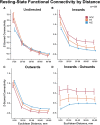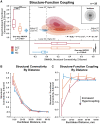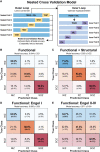The Interictal Suppression Hypothesis in focal epilepsy: network-level supporting evidence
- PMID: 36722219
- PMCID: PMC10316780
- DOI: 10.1093/brain/awad016
The Interictal Suppression Hypothesis in focal epilepsy: network-level supporting evidence
Abstract
Why are people with focal epilepsy not continuously having seizures? Previous neuronal signalling work has implicated gamma-aminobutyric acid balance as integral to seizure generation and termination, but is a high-level distributed brain network involved in suppressing seizures? Recent intracranial electrographic evidence has suggested that seizure-onset zones have increased inward connectivity that could be associated with interictal suppression of seizure activity. Accordingly, we hypothesize that seizure-onset zones are actively suppressed by the rest of the brain network during interictal states. Full testing of this hypothesis would require collaboration across multiple domains of neuroscience. We focused on partially testing this hypothesis at the electrographic network level within 81 individuals with drug-resistant focal epilepsy undergoing presurgical evaluation. We used intracranial electrographic resting-state and neurostimulation recordings to evaluate the network connectivity of seizure onset, early propagation and non-involved zones. We then used diffusion imaging to acquire estimates of white-matter connectivity to evaluate structure-function coupling effects on connectivity findings. Finally, we generated a resting-state classification model to assist clinicians in detecting seizure-onset and propagation zones without the need for multiple ictal recordings. Our findings indicate that seizure onset and early propagation zones demonstrate markedly increased inwards connectivity and decreased outwards connectivity using both resting-state (one-way ANOVA, P-value = 3.13 × 10-13) and neurostimulation analyses to evaluate evoked responses (one-way ANOVA, P-value = 2.5 × 10-3). When controlling for the distance between regions, the difference between inwards and outwards connectivity remained stable up to 80 mm between brain connections (two-way repeated measures ANOVA, group effect P-value of 2.6 × 10-12). Structure-function coupling analyses revealed that seizure-onset zones exhibit abnormally enhanced coupling (hypercoupling) of surrounding regions compared to presumably healthy tissue (two-way repeated measures ANOVA, interaction effect P-value of 9.76 × 10-21). Using these observations, our support vector classification models achieved a maximum held-out testing set accuracy of 92.0 ± 2.2% to classify early propagation and seizure-onset zones. These results suggest that seizure-onset zones are actively segregated and suppressed by a widespread brain network. Furthermore, this electrographically observed functional suppression is disproportionate to any observed structural connectivity alterations of the seizure-onset zones. These findings have implications for the identification of seizure-onset zones using only brief electrographic recordings to reduce patient morbidity and augment the presurgical evaluation of drug-resistant epilepsy. Further testing of the interictal suppression hypothesis can provide insight into potential new resective, ablative and neuromodulation approaches to improve surgical success rates in those suffering from drug-resistant focal epilepsy.
Keywords: EEG; connectivity; diffusion imaging; epilepsy; inhibition excitation.
© The Author(s) 2023. Published by Oxford University Press on behalf of the Guarantors of Brain. All rights reserved. For permissions, please e-mail: journals.permissions@oup.com.
Conflict of interest statement
The authors report no competing interests.
Figures







Comment in
-
Resting But Not Idle: Insights Into Epilepsy Network Suppression From Intracranial EEG.Epilepsy Curr. 2023 Nov 30;24(1):25-27. doi: 10.1177/15357597231213247. eCollection 2024 Jan-Feb. Epilepsy Curr. 2023. PMID: 38327528 Free PMC article.
References
-
- Behr C, Goltzene MA, Kosmalski G, Hirsch E, Ryvlin P. Epidemiology of epilepsy. Rev Neurol (Paris). 2016;172:27–36. - PubMed
Publication types
MeSH terms
Grants and funding
- R01 NS075270/NS/NINDS NIH HHS/United States
- T32 EB001628/EB/NIBIB NIH HHS/United States
- R01 NS112252/NS/NINDS NIH HHS/United States
- F31 NS106735/NS/NINDS NIH HHS/United States
- T32 GM007347/GM/NIGMS NIH HHS/United States
- R00 NS097618/NS/NINDS NIH HHS/United States
- R01 NS108445/NS/NINDS NIH HHS/United States
- R01 NS095291/NS/NINDS NIH HHS/United States
- T32 EB021937/EB/NIBIB NIH HHS/United States
- R01 NS110130/NS/NINDS NIH HHS/United States
- P50 HD103537/HD/NICHD NIH HHS/United States
- F31 NS131056/NS/NINDS NIH HHS/United States

